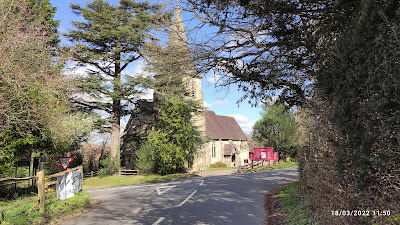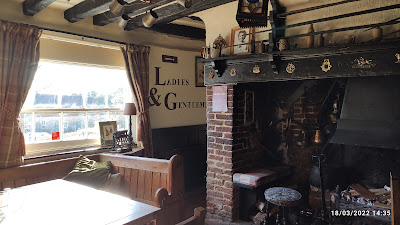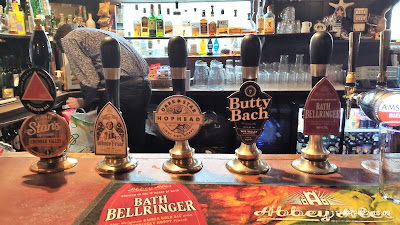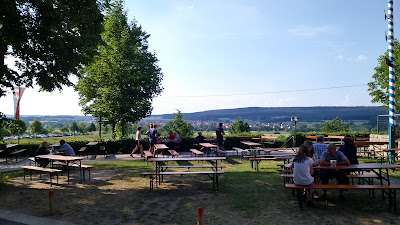Friday just gone, saw yours truly heading off on another bus trip, and on what turned out to be the hottest day of the year so far, what better way to spend it than visiting four rural pubs along the upper reaches of the Medway Valley, close to the route of the former Three Bridges–Tunbridge Wells rail line.
A spot of detective work revealed that Metro Bus operate an hourly service (No. 291), between Tunbridge Wells and Crawley, via East Grinsted and Forest Row. Knowing there is a rich seam of attractive rural pubs along this route, prompted me into allocating Friday as the day for trying out this route.
The beauty of the 291 route, is its frequency, and with buses running in both directions, at hourly intervals, the scope for visiting three or four pubs over the course of the day, suddenly becomes very real. So, with printed timetable to hand, I set off armed with bus pass, plus a packed lunch, to make the short journey to Tunbridge Wells, and then see where the 291 would take me.
There wasn’t a cloud in the sky, as I stood waiting at the bus stop, opposite the entrance to the Royal Victoria Place shopping centre. I opted for the 10.48 bus, with the intention of travelling as far as Coleman’s Hatch, a tiny settlement on the edge of Ashdown Forest. I could then take a short, 10-minute walk up to the atmospheric Hatch Inn; an attractive, low-beamed old pub, which started life as three 15th Century cottages. It all depended on bus arrival and
departure times, plus that old chestnut and bane of many a pub-ticker’s schedule,
pub opening times. The bus I was travelling on would drop me opposite the
church in Coleman’s Hatch at 11.18, and with a 10-minute walk to the Hatch Inn,
I would arrive just in time for an 11.30 opening time. There was conflicting information on the
pub’s actual opening, with What Pub stating 11.30, and the pub’s website also
showing 11.30 opening, but midday for food. I phoned the pub, several times,
the day before, but no-one answered, so throwing caution to the wind I went for
broke, alighted opposite the church, and headed uphill towards the Forest and
the Hatch Inn.
It all depended on bus arrival and
departure times, plus that old chestnut and bane of many a pub-ticker’s schedule,
pub opening times. The bus I was travelling on would drop me opposite the
church in Coleman’s Hatch at 11.18, and with a 10-minute walk to the Hatch Inn,
I would arrive just in time for an 11.30 opening time. There was conflicting information on the
pub’s actual opening, with What Pub stating 11.30, and the pub’s website also
showing 11.30 opening, but midday for food. I phoned the pub, several times,
the day before, but no-one answered, so throwing caution to the wind I went for
broke, alighted opposite the church, and headed uphill towards the Forest and
the Hatch Inn.
The forest roads were surprisingly busy, and with speeding motorists, driving like there was no tomorrow, I needed my wits about me to avoid being hit. After cresting the brow of a hill, and traversing a busy junction, I could see the pub, a short distance away where the road began to level out again. As I approached, I could see lights on inside, and the outside Gin Bar appeared open as well. All were good signs and so was the front door, which opened as I clicked the latch. Full of confidence, I approached the bar, only to be told by a woman who appeared from behind a curtain, that the pub was closed. A brief conversation about opening times then ensued, which resulted with her saying that if I only wanted a drink, I could have one! Perhaps she took pity on me, but whatever the reason, I accepted her offer.
Thinking ahead, I thought that if I just had a half, I could still make the 12.02 return service, and visit the next pub. Harvey’s Best, Old Ale plus a beer from Bedlam Brewery, were the choices, and despite my reticence that the beer might not have been pulled through yet, from the previous evening, I opted for a half of Old.
I was glad it was just a half, as the beer was a little “tired,” but I was also glad of the opportunity of nosing around the pub and taking a few photos. My only previous visit to the Hatch, had been on a vintage bus trip, organised by Maidstone CAMRA, back in 2015, and with a bus load of thirsty CAMRA members, in what is quite a small pub, it was difficult to take any meaningful photos.
So, with just myself and the barmaid present, I was able to snap away at will and appreciate all that one might expect from such an ancient building. This included the low sloping ceilings, supported by ancient beams, and a bar which occupies a central location. This opens up either side, into what are two separate rooms, with a log fire at one end providing a warming welcome. The barmaid was on the phone as I was about to depart, but I shouted my thanks as I made for the door. It was downhill most of the way back to Holy Trinity church, and the bus stop for services back to Tunbridge Wells. I arrived in plenty of time, and although the bus was several minutes late, it was pleasant standing there in the warm, early spring sunshine. My next port of call was only a few stops away, and it was a pub I hadn’t been to before, despite having driven past it quite few times. The Gallipot Inn, on the edge of Upper Hartfield, is an attractive, 16th Century pub, close to the edge of the road. It is a long, low building with a lower portion constructed from blocks of local sandstone, and a weatherboard upper section. The internal layout seemed quite similar to that of the Hatch Inn, with a beer range almost to match. This time it was Cellar Head Session Pale complementing the Sussex Best although I stuck with the Harvey’s. There were a few diners inside, some with their canine companions tucked away under the tables but given the fine weather I took my pint out and sat at one of the tables enjoying my pint in the warm sunshine. With very few cars passing by, it seemed a world away from the troubles of the outside world. I wasn’t alone as there was a couple and their dog, plus the odd jobbing builder – some building work was taking place at the rear of the pub. I later found out, after talking to a work colleague, that there is a pleasant garden behind the Gallipot, with views back across the valley, over to the High Weald. An hour later, I was at the bus stop, directly in front of the pub, waiting for the next bus heading east. I jumped on and sat down for just a few stops until we reached the tiny village of Withyham, home to the legendary Dorset Arms. I say legendary because this lovely old pub has a soft spot in the hearts of those who appreciate unspoilt country pubs. The Dorset started life as a 16th Century farmhouse before coming an alehouse in the 18th Century. For decades the pub has forms part of the Buckhurst Estate, owned by Earl De La Warr, whose arms are depicted on the pub sign. It is a listed building, complete with log fie in winter, and a wealth of old beams. It retains a public bar, which looks through, in places, to a much larger restaurant area. I have always known the Dorset as a Harvey’s pub, but it appears that the brewery only leased it from the estate, and it has now reverted back to its original owners. My last visit to the pub involved an overnight stay in the village, whilst walking the Weald Way, long-distance footpath. My companion Eric and I had stayed at a B&B, housed in the Old Post Office, opposite the pub, and had enjoyed an excellent meal that evening, along with several pints of Harvey’s Best.
I’m not sure whether the Old Post Office still functions as a B&B, but today the Dorset offers overnight accommodation. I remember the father of a friend of ours telling us that him and his wife spent their honeymoon at the pub, which doesn’t surprise me as Tony was a connoisseur of unspoiled, traditional pubs, long before appreciation of old alehouses became more mainstream. I certainly enjoyed my long overdue, return visit, sitting at the bar enjoying the finest pint of Sussex Best I’d had in a long time. There was a good mix of customers in the public bar, including, but not confined to, drinkers like me. The bar staff were friendly, with the barmaid on first name terms with the group of carpenters who were celebrating the birthday of one of their team. On the other side of the partition, the restaurant looked busy, and I imagine it must have been reservations only.
I drank up and walked over to the bus stop, for the short ride to Groombridge, a village that is part in Kent and part in Sussex. The oldest part is in Kent, and at the end of a row of rustic looking, brick-built cottages, is the Crown Inn, overlooking the village green. The pub dates from the 16th Century, and with its brick floors, old beams, and several interconnecting rooms, it is not hard to imagine it during those times.
Groombridge Place, a 17th Century moated, manor house is at the bottom of the hill, and the extensive gardens and “enchanted forest” are a popular visitor attraction during the summer months. Groombridge was also once an important railway junction, but all that remains today are the heritage trains that operate on the Spa Valley Railway, between Tunbridge Wells West and Eridge. Returning to the pub, Harvey’s Best and Larkin’s Traditional, were the cask ales on sale. I took my pint of Trad outside, and sat at one of the wooden bench tables, enjoying the view as well as the excellent Larkin’s beer. I also finished off the pre-prepared cheese rolls I had brought with me, by way of lunch. BRAPA would have been proud of me, I chuckled to myself, although he would have tried scoffing them inside the pub! There was only time for one pint, as the Crown closes between 3 and 5.30 pm. I also had a bus to catch back to Tunbridge Wells. I was lucky with connections, because as the 291 pulled up in Tunbridge Wells, opposite the War Memorial, the No. 7 to Tonbridge was just about to leave. I jumped off the former and hopped onto the latter. It wasn’t quite so lucky when the bus picked up a full complement of pushing, shoving and plague-infected school kids, from outside the local grammar school.
I was glad of the FFP2 face mask I was wearing, but if truth be known I didn’t let the minor inconvenience of a bus load of excited kids, released for the weekend, detract from what had been one of the most enjoyable and productive bus trips, I’ve experienced to date.































































